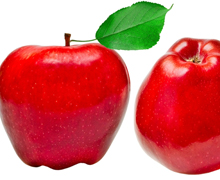
When brightly colored foods like strawberries, peppers and apples look appealing to you it may just be your brain’s way of telling you what it craves. That’s because the results of a recent study published in the journal Neurology show a diet with at least a half serving a day of foods high in flavonoids may lower the risk of cognitive decline by 20 percent.
Flavonoids are powerful antioxidants that support your body’s defenses. They are commonly found in brightly colored fruits and vegetables. Not enough antioxidants in the diet are thought to contribute to cognitive decline as people age.
"There is mounting evidence suggesting flavonoids are powerhouses when it comes to preventing your thinking skills from declining as you get older," said study author Walter Willett, MD, PhD, of Harvard University. "Our results are exciting because they show that making simple changes to your diet could help prevent cognitive decline."
The study conducted over a span of 20 years consisted of nearly 50,000 women and 28,000 men with an average starting age of 51. They completed several questionnaires during the study to determine what kinds of food they ate. Their flavonoid intake was calculated according to the potency of the foods and the frequency with which they were consumed.
The study participants had their cognitive abilities assessed twice a year through other questionnaires that asked about their ability to remember events as well as items on a list. This was used as a way to measure early memory problems that were bad enough to notice but not necessarily bad enough to be detected on a formal screening test.
The group with the highest flavonoid consumption had roughly 600 milligrams per day in their diet while the lowest 20 percent of study participants had about 150 mg per day. For comparison, strawberries have about 180 milligrams of flavonoids per 100 gram serving. Apples have about 113.
Researchers adjusted for factors like age and calorie intake and found those who consumed more flavonoids had a lower risk of cognitive decline. The highest consumption group had 20 percent lower risk than those in the lowest consumption group.
Several types of flavonoids were studied with flavones and anthocyanins found to provide the most protection against cognitive decline. Flavones, which are found in some spices and yellow or orange produce was associated with a 38 percent reduction in risk of cognitive decline. Researchers equate that to being three to four years younger in brain age.
Anthocyanins from blueberries, blackberries and cherries were associated with a 24 percent lower risk in cognitive decline.
"The people in our study who did the best over time ate an average of at least half a serving per day of foods like orange juice, oranges, peppers, celery, grapefruits, grapefruit juice, apples and pears," Willett said. "While it is possible other phytochemicals are at work here, a colorful diet rich in flavonoids—and specifically flavones and anthocyanins—seems to be a good bet for promoting long-term brain health. And it's never too late to start, because we saw those protective relationships whether people were consuming the flavonoids in their diet 20 years ago, or if they started incorporating them more recently."
